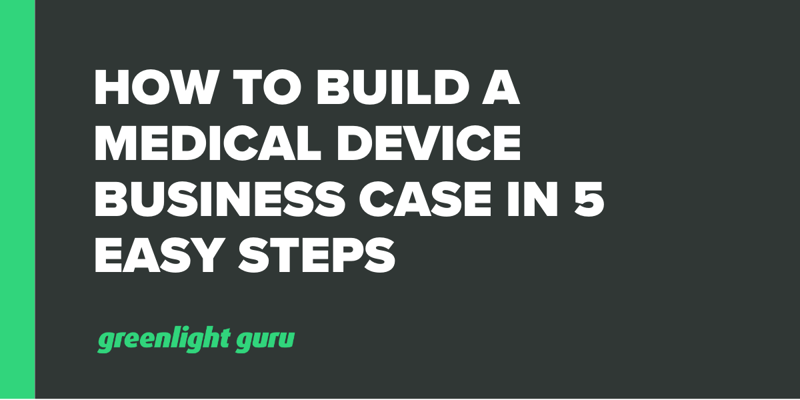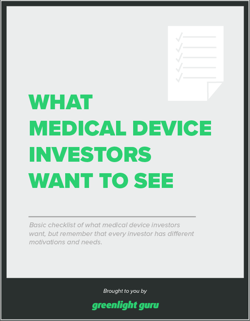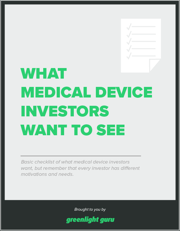How to Build a Medical Device Business Case in 5 Easy Steps

In business, so much of success depends on timing. A product launches too early and is misunderstood by the market; a product launches too late and becomes another face in the crowd.
The margins for error are already thin, and in the heavily competitive and regulated medical device industry they become almost nonexistent. So making the right decision isn’t something to take lightly.
That’s why the most agile companies use a medical device business case to make and present their decisions to company stakeholders, such as product teams, C-suite executives, or investors.
While there is much to consider when developing medical device business cases, thankfully it doesn’t have to be a shot in the dark. Let’s take a look at some foundational info about medical device business cases, and five easy steps to develop your own.
What is a Medical Device Business Case?
When medtech organizations spot a potential market opportunity, they’ll often use a carefully constructed business case as a decision-making tool. When carefully constructed, the business case provides a framework to explore the pros, cons, and potential value for a proposed solution to an ongoing or forthcoming opportunity.
It should be noted that a business case is not the same as a business plan. A business plan is used to outline decisions at the organizational level, such as how and why a business should exist. Business cases, on the other hand, support product level decisions, such as how and why a new line of products should be developed as a solution to a specific market opportunity.
Business cases are a highly effective and efficient way to communicate a decision to stakeholders. This is largely thanks to its format, in which each step is built atop insights gleaned from the one preceding it, providing the audience with the necessary context as to why the decision should be made.
However, this iterative process places much more emphasis on the research—faulty data means inaccurate insights and conclusions. So, when working through these five steps for building a medical device business case, be sure to dedicate significant time and attention to each step.
You’ll also want to consider the following medical device business case best practices:
-
Rely heavily on input from subject matter experts (SMEs) and end users
-
Keep risk and regulations top of mind
-
Insights should always be grounded in data
-
Stay realistic about your team’s capabilities and time
-
Customize your presentation to your audience
Build a medical device business case in 5 steps
Now let's dive into building a medical device business case, starting with step 1.
Step 1: Define the Current Situation or Opportunity
Key Questions to Answer:
-
Who is the customer? Who is our customer’s customer?
-
What is our problem or opportunity?
-
How do I best characterize the current situation?
-
What is the current cost of the situation?
In this first step, you’ll need to clearly articulate the situation, whether it’s a problem to be solved or an opportunity to be leveraged. Try to keep your focus centered on the impact and needs of the customer — and that means all customers, external and internal.
Keep in mind that all companies are unique, with their own culture, mission, and values. A solution that fits with one company may be a nonstarter with another. Be sure you’re validating your definition of the opportunity or problem with management.
In order to keep track of so many internal and external pain points, speak with as many people as possible — this means talking to different departments and subject matter experts like doctors and surgeons, and device users, if possible.
Step 2: Develop Success Criteria
Key Questions to Answer:
-
What is the value proposition?
-
What are the benefits and timing of value creation?
-
What will it look like if we implement the plan?
Another critical definition in a business case is how you’ll determine whether the solution is successful. To do so, you’ll need to find ways to quantify the value to the business once the opportunity is realized or the problem is solved.
Organizing your thoughts around this issue can be tough, especially when they feel fairly nebulous. A good strategy to ground your thinking is to set parameters like timeframe, profit/loss amounts, or budget restrictions. You may find that a situation is more or less dire than you anticipated, and therefore requires a different approach altogether.
You’ll be looking at various KPIs that impact various departments and areas of business. When doing so, don’t forget to prioritize the areas that matter most. As with the previous step, validate the criteria with all department heads, especially those in finance and marketing.
Step 3: Research Alternatives
Key Questions to Answer:
-
What alternatives do we have?
-
How do we deliver the benefits to our customer
-
What is the cost of doing nothing?
-
What relationships do I need to consider?
Great solutions don’t happen without great alternatives. Why? Because great decision making depends on you to be unbiased and properly informed. When we enter the process with a predetermined solution in mind, it’s easy to slip the blinders on and ignore other, more potentially valuable alternatives.
Of course, just as every business is unique, so too are the scenarios and protected impacts of alternative solutions. You’ll also need to refer back to the success criteria outlined in the previous step. These will help you prioritize the KPIs that matter most to your business.
For instance, an acquisition option of a rival technology may have a shorter timeframe but it also has high upfront costs. Developing a “me-too” product may take longer, but has potentially lower costs in the long run. There may even be hybrid options which combine multiple alternatives. The point here is to ensure you fully explore the spectrum of choices for your business case.
Step 4: Analyze and Select a Path Forward
Key Questions to Answer:
-
What key resources are needed to implement the plan?
-
What activities are most important and what is the timing?
-
How do we quantify the financial impact to the company?
Now comes the hardest part of decision-making: deciding. No one wants to end up making the wrong choice, especially when it could result in lower quality medical devices, increased risk for your patients, or the loss of jobs for your internal department. Even for the most confident individuals, that’s a heavy load to bear.
Selecting a path forward should focus on the following areas:
-
Financial impact
-
Personnel impact
-
Resources Needed
-
External relationships required
-
Any changes to key activities of the business
For medical device industry veterans, it’s a good chance to adopt a risk-based approach. When considering potential impacts, be as specific as possible — the extent of these impacts may not be apparent on a surface level.
You may even tap your QA/RA department for assistance with the risk management approaches laid out in ISO 14971, or using SWOT techniques to identify strengths, weaknesses, opportunities, and threats.
Step 5: Present the Plan
Key Questions to Answer:
-
What is most important to convey?
-
What is best left for the appendix?
-
Who is my audience and what is the most effective way to present my case?
All the work you’ve put in has led to this moment: a carefully constructed argument that’s communicated clearly. But even with all the analysis, conversations, and ruminating, a poorly prepared presentation could cause the stakeholders to lose faith in your plan..
Your primary focus should be on the why of the business case, and that means demonstrating value to the business. Don’t get muddled down in the weeds of methodology, or in-depth statistical analysis; save extensive data for an appendix provided to attendees. Instead, highlight the basics, and bridge the gap from the current situation to the vision that was cast.
Finally, consider your audience. What are they like? How do they communicate? How many people are involved in approval? How familiar are they with the current scenario? All of these factors should help you in creating a presentation that actually sells them on the idea without feeling like you’re selling anything at all.
Understand the impact of every decision with Greenlight Guru
It’s clear that making decisions isn’t something that’s done in a single moment. These are choices that will have a major impact on all areas of your business and the quality of life for all users. So, while you’re considering your next move, here’s another question: Can you leverage your eQMS platform to ensure you’re making an informed decision?
Greenlight Guru helps your entire team achieve closed-loop traceability by allowing you to efficiently navigate through your quality system, making connections and understanding the relationships within your QMS and how they affect your business.
Contact us today for your free, personalized demo of Greenlight Guru!
Looking for an all-in-one QMS solution to advance the success of your in-market devices and integrates your quality processes with product development efforts? Click here to take a quick tour of Greenlight Guru's Medical Device QMS software →
Etienne Nichols is the Head of Industry Insights & Education at Greenlight Guru. As a Mechanical Engineer and Medical Device Guru, he specializes in simplifying complex ideas, teaching system integration, and connecting industry leaders. While hosting the Global Medical Device Podcast, Etienne has led over 200...
Related Posts
Managing Major Changes to Medical Device Packaging
eQMS Buyer’s Guide: Making the Business Case for a New QMS Solution
Let The Document Tell The Story: Document Management Best Practices
Get your free resource
What Medical Device Investors Want to See











